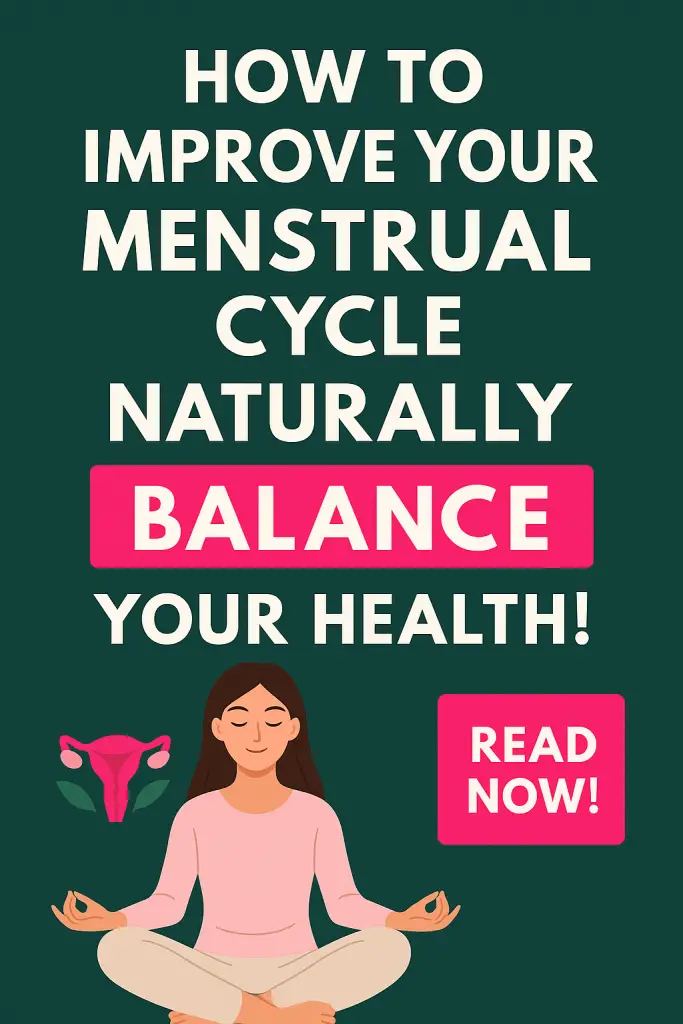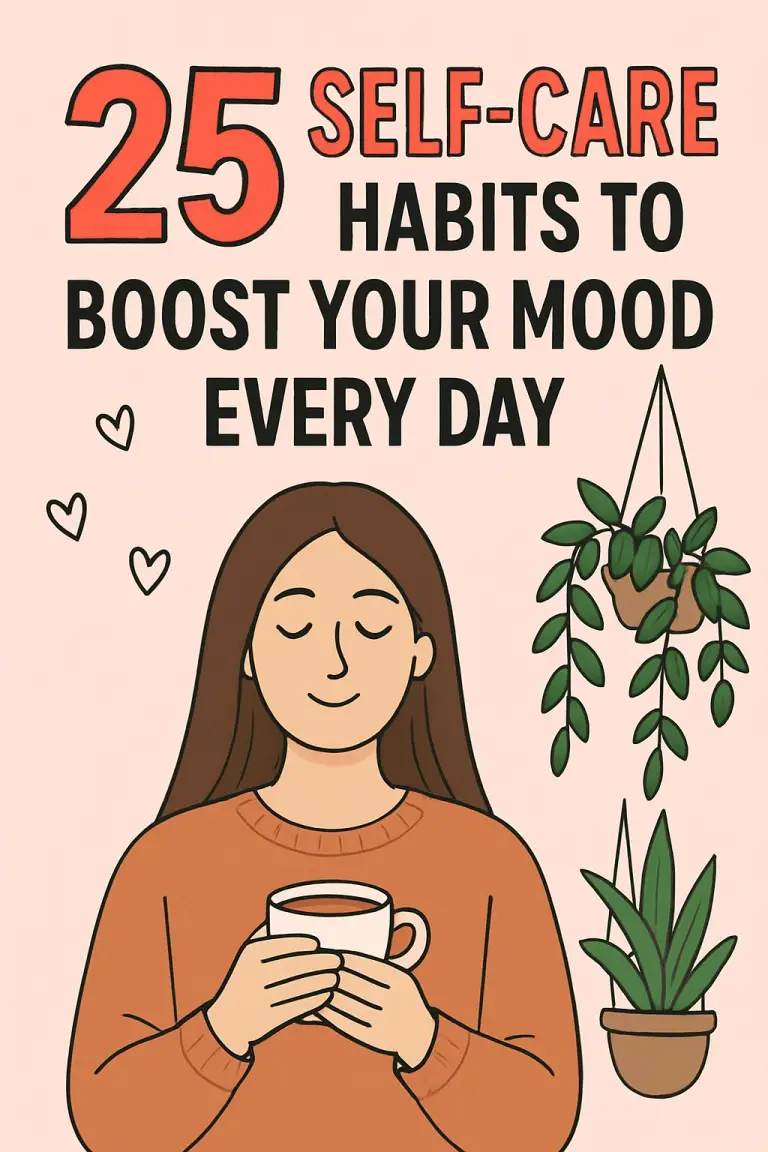How to Improve Your Menstrual Cycle Naturally

Let’s be real — dealing with your period isn’t always a walk in the park. Some months it’s smooth sailing, other months you feel like your body is staging a rebellion. Maybe your cycle is irregular, the cramps are unbearable, or PMS has you snapping at innocent bystanders (been there 🙋♀️). If you’ve ever thought, “There has to be a way to make this easier,” you’re not alone.
I personally remember when my cycle was all over the place in my early 20s. Stress, poor diet, and lack of sleep left me guessing every month. It wasn’t until I started experimenting with natural remedies — things like adjusting my nutrition, getting better rest, and supporting my hormones — that I finally noticed real improvements. And trust me, once you realize how much control you can have, it feels like a total game-changer.
So, let’s dive in and talk about how you can improve your menstrual cycle naturally, without relying solely on medications or crossing your fingers hoping it “just fixes itself.”

Understanding Your Menstrual Cycle
Before we talk fixes, let’s do a quick refresher. Your menstrual cycle isn’t just about bleeding for a few days every month. It’s a complex hormonal rhythm that usually runs around 28 days (though anything between 21–35 days is considered normal).
The Four Phases of Your Cycle
- Menstrual Phase (Days 1–5) – Bleeding begins as your body sheds the uterine lining.
- Follicular Phase (Days 1–13) – Estrogen rises, follicles in the ovaries develop, and energy usually improves.
- Ovulation (Day 14, give or take) – The ovary releases an egg. This is the most fertile window.
- Luteal Phase (Days 15–28) – Progesterone dominates, preparing the uterus for pregnancy. PMS tends to rear its head here.
When these phases flow smoothly, life is good. But when hormones are imbalanced, symptoms like irregular cycles, painful cramps, heavy bleeding, or wild PMS can show up.
Natural Ways to Improve Your Menstrual Cycle
1. Nourish Your Body With the Right Foods
You’ve heard the saying, “You are what you eat.” Well, your menstrual cycle totally agrees.
Eat Cycle-Friendly Nutrients
- Iron-rich foods (spinach, red meat, beans) help replenish blood lost during your period.
- Magnesium (dark chocolate, nuts, seeds) eases cramps and supports hormone balance.
- Omega-3 fatty acids (salmon, chia seeds, walnuts) reduce inflammation and may ease PMS symptoms.
- Complex carbs (quinoa, brown rice, sweet potatoes) keep blood sugar stable, which helps with mood swings.
Limit Hormone-Disruptors
- Cut back on processed sugars, which can spike insulin and worsen PMS.
- Reduce caffeine and alcohol, since they can mess with hormones and worsen cramps.
- Avoid highly processed junk food — IMO, your uterus will literally thank you.
2. Stay Hydrated
This may sound too simple, but dehydration can make cramps worse, cause bloating, and even affect cycle regularity. Aim for 8–10 glasses of water daily. Pro tip: adding a pinch of sea salt or electrolytes can help if you lose a lot of fluids during heavy cycles.
3. Exercise Smart (Not Excessive)
Movement can work wonders, but balance is key.
- Low to moderate exercise like walking, yoga, or cycling reduces PMS, boosts mood, and improves blood flow.
- Strength training during the follicular phase can be especially effective since energy levels are higher.
- Avoid overtraining, which can suppress ovulation and even stop your period altogether.
Remember: your workouts can be synced with your cycle phases. For example, try intense workouts post-period, and lighter, restorative movement during PMS.
4. Manage Stress Levels
Stress is one of the biggest culprits behind irregular or painful cycles. Your body doesn’t always know the difference between a tight deadline and being chased by a tiger — it just pumps out cortisol. And high cortisol can disrupt reproductive hormones.
Simple Stress-Relief Habits
- Meditation or deep breathing (just 10 minutes daily makes a difference).
- Journaling to release emotions.
- Nature walks to reset your nervous system.
- Hobbies like painting, dancing, or reading for pure joy.
5. Prioritize Sleep
Poor sleep = hormonal chaos. While you snooze, your body resets hormone production, especially melatonin and cortisol, which indirectly influence reproductive health.
- Aim for 7–9 hours of quality sleep.
- Keep a consistent bedtime and wake-up time.
- Reduce blue light from phones an hour before bed.
6. Support Your Cycle With Herbs and Natural Remedies
Many cultures have used herbal medicine for centuries to support women’s cycles. Always consult your healthcare provider before trying new supplements, but here are a few that have shown promise:
- Vitex (Chasteberry): Supports progesterone levels and reduces PMS.
- Ginger: Helps with cramps and heavy bleeding.
- Turmeric: Anti-inflammatory and may ease period pain.
- Cinnamon: Supports blood sugar balance and reduces cycle pain.
7. Track Your Cycle
Gone are the days of guessing when your period will hit. With apps or even a simple journal, you can track symptoms, length, flow, and moods.
Why bother? Because:
- It helps identify patterns and triggers.
- You can anticipate PMS and plan accordingly.
- It empowers you to have better conversations with your doctor if needed.
8. Balance Hormones Naturally
Sometimes cycle issues come down to hormonal imbalance. While extreme cases may need medical intervention, you can support balance naturally.
Tips to Nudge Hormones Back in Sync
- Eat enough healthy fats (avocado, olive oil, fatty fish) for hormone production.
- Avoid endocrine disruptors like BPA in plastics.
- Maintain a healthy body weight (both underweight and overweight can mess with cycles).
- Get sunlight exposure for vitamin D, which plays a big role in reproductive health.
9. Listen to Your Body’s Signals
Your body is constantly dropping hints — the question is, are you listening? Things like fatigue, mood changes, bloating, and skin breakouts can all be linked to cycle health.
Instead of ignoring these red flags, start treating them as clues. The sooner you respond, the quicker you can bring your cycle back into balance.
When to Seek Medical Advice
While natural remedies are fantastic, it’s important to know when to get professional help. If you experience:
- Extremely heavy bleeding (soaking through pads/tampons every hour).
- Cycles shorter than 21 days or longer than 35 days consistently.
- Severe cramps that don’t respond to natural remedies.
- Missed periods for several months.
These may be signs of conditions like PCOS, endometriosis, or thyroid issues that need medical attention.
Conclusion
Improving your menstrual cycle naturally isn’t about finding a quick fix — it’s about making small, sustainable lifestyle choices that add up over time. From eating nourishing foods and managing stress, to syncing workouts with your cycle and tracking symptoms, each step brings you closer to a smoother, healthier rhythm.
Think of it as working with your body rather than against it. Sure, it takes some effort, but the payoff — less pain, more predictability, better moods — is 100% worth it.
So, next time Aunt Flo comes knocking, you’ll be ready. 😉 Your cycle doesn’t have to feel like an enemy. With the right natural strategies, it can become just another part of your amazing, powerful body’s rhythm.






